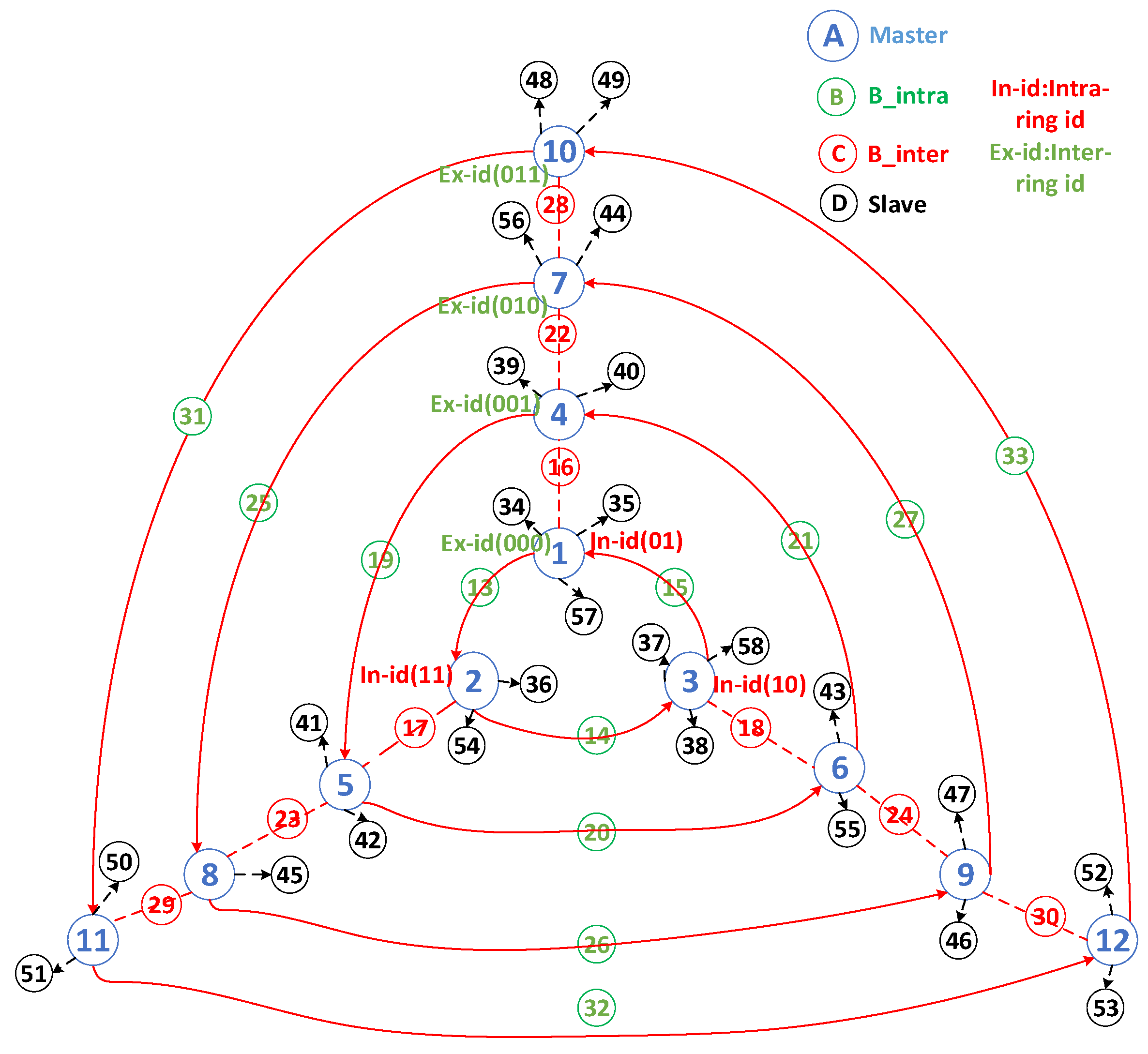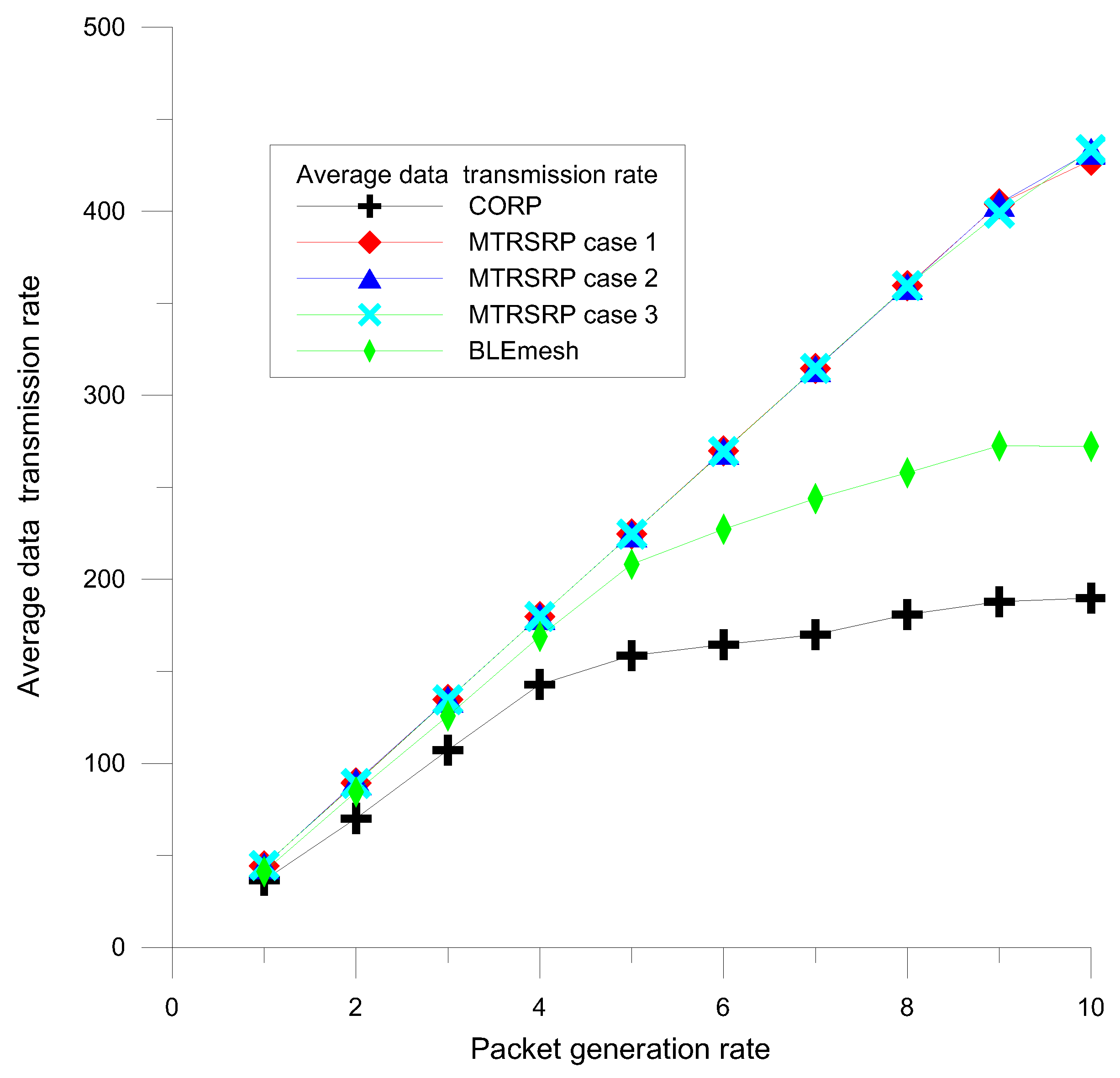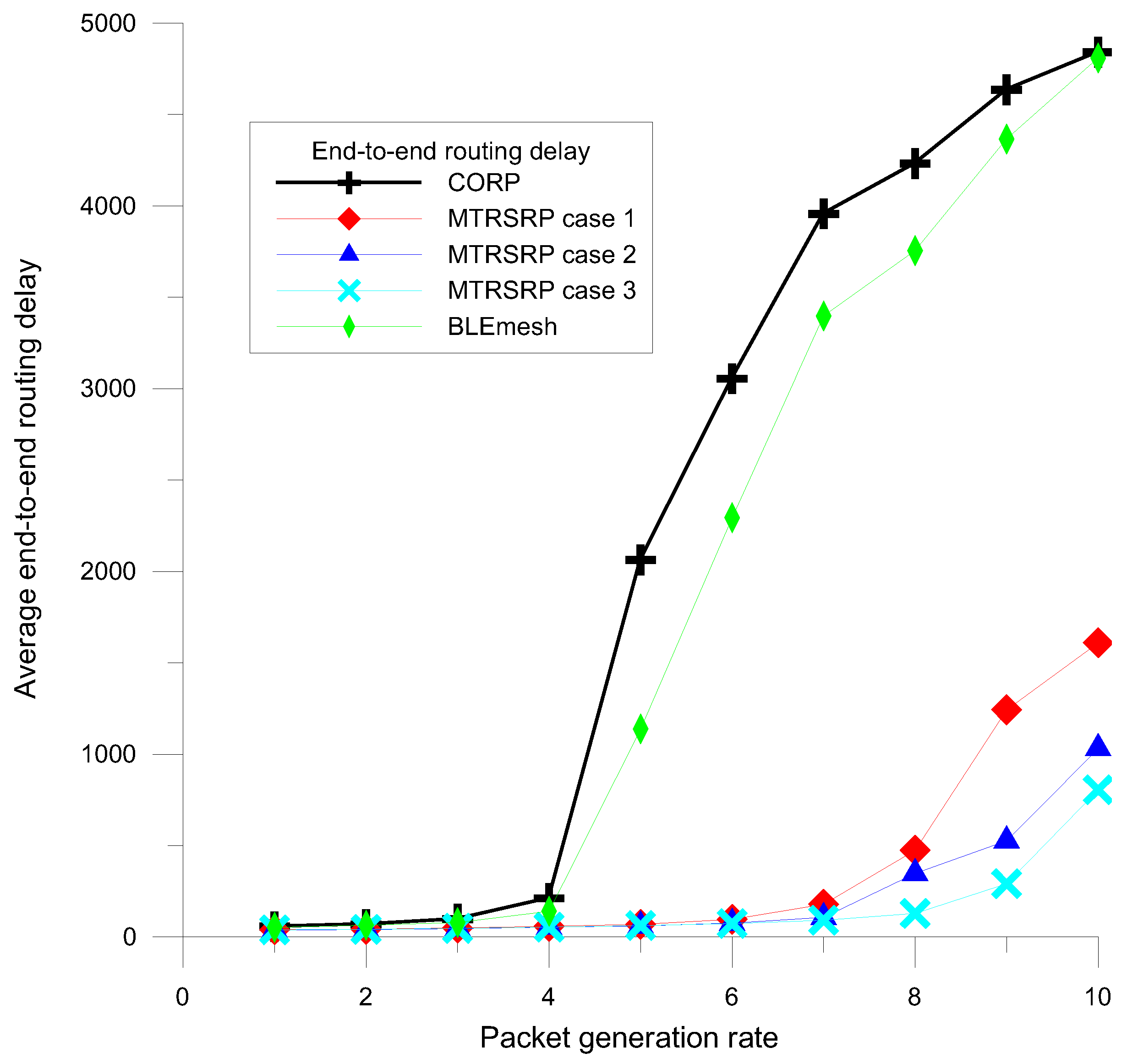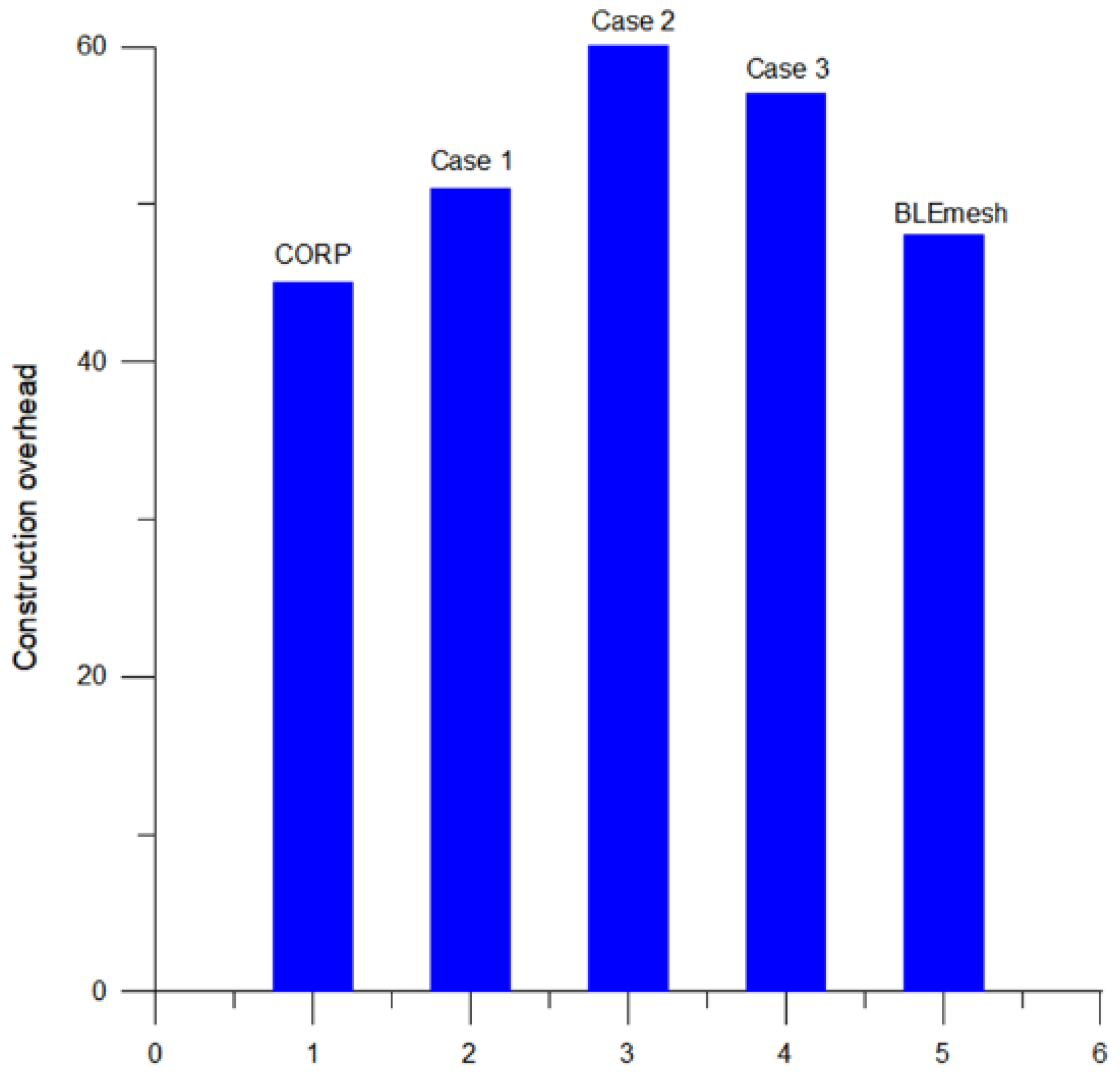MTRSRP: Joint Design of Multi-Triangular Ring and Self-Routing Protocol for BLE Networks
Abstract
1. Introduction
- (1)
- Decentralized Control
- (2)
- Competitive Leader Election
- (3)
- Multi-Triangular Ring Scatternet
- (4)
- Dual Bridge Connections
- (5)
- Self-Routing with Shortest path
2. Related Work
3. Motivation
- (R1)
- According to the Bluetooth Core Specification, each master node can support up to seven active slave nodes due to the 3-bit address space (AM_ADDR). This constraint ensures stable scheduling and connection management under time-division duplexing (TDD).
- (R2)
- Each piconet is connected to others through slave/slave (S/S) bridge nodes. This supports stable scatternet construction without routing overhead, especially during topological changes, and improves resilience through decentralized ring-based connectivity.
- (R3)
- Each bridge node is limited to connecting two piconets to reduce time-division switching complexity, avoid communication overload, and minimize energy consumption on resource-constrained BLE devices.
- (R4)
- Limiting the connections between two piconets to one or two bridges helps define the minimum number of required piconets and ensures deterministic termination of the formation protocol. It also avoids routing loops and supports modular ring construction.
4. The Proposed MTRSRP
4.1. System Architecture
- Piconets: Fundamental network units, each comprising one master node and several slave nodes;
- Rings: Higher-level structures comprising interconnected piconets managed by intra- and inter-ring bridges;
- Coordinator: A master node with additional responsibilities, such as collecting network data and coordinating the formation of the scatternet.
- (1)
- Node Discovery: Nodes alternate between advertiser and scanner roles to discover neighbors and exchange IDs and neighbor counts. Advertisers broadcast their IDs on designated channels, and scanners collect the information. This process continues until the nodes fully understand their immediate neighbors.
- (2)
- Coordinator Election: Nodes compete to become coordinators based on the collected neighbor information. The node with the highest neighbor count is elected as the coordinator. The coordinator then gathers timing information, node addresses, and neighbor counts from all the nodes.
4.2. Multi-Triangular Ring Formation
- CASE 1: ONLY ONE B_INTER AND ONE B_INTRA BRIDGE EXISTS BETWEEN TWO PICONETS.
- CASE 2: ONE B_INTRA BRIDGE CONNECTS TWO PICONETS WITHIN A RING, WHEREAS TWO B_INTER BRIDGES CONNECT PICONETS ACROSS THE RINGS.
- CASE 3: TWO B_INTRA BRIDGES INTERCONNECT TWO PICONETS WITHIN A RING, AND ONLY ONE B_INTER BRIDGE CONNECTS PICONETS ACROSS THE RINGS.
- (1)
- The leader election phase:
| Algorithm 1. Pseudocode of the node discovery process. |
| Input: N nodes are randomly deployed in a given area Output: Several masters are elected to own the neighbors’ information Init: Start discovery timer T1 |
| while (T1 > 0) Nodes Start timer T2 and randomly act as advertisers or scanners if (T2 > 0) if (Random_op = advertiser) Advertising its own ID and the number of neighbors else Scanning channels 37, 38, and 39 to update neighbor list end if else Switch roles and repeat the above advertising and scanning process if any two nodes exchange information with each other Compare their neighbor lists if the node has the most neighbors, it becomes a master and resets timer T2 else the node becomes a slave end if end if end if end while |
| Algorithm 2. Pseudocode for determining a coordinator. |
| while (the final winning master is not determined and T2 < T) If p > 0.5 in each master, the master is assigned to the scan mode else the master is assigned to the advertise mode end if if any two masters exchange information with each other Compare their neighbor list if the number of neighbors is equal The winner is the node with the smaller Bluetooth ID, and becomes as a master else the node with the most neighbors becomes the winning master The losing node becomes as slave, and will deliver its neighbor list to the winner. The losing nodes are removed until the final winning master is determined. end if end if end while |
- (2)
- The scatternet formation phase:
4.3. Self-Routing Protocol of MTRSRP
| Algorithm 3. Pseudocode of the binary label assignment procedure. |
| Procedure: AssignBinaryLabels(RootNode, MaxRings, K) Input: RootNode: coordinator node, MaxRings: maximum number of rings, K: branching factor per node Output: LabelMap: mapping from each node to its full binary label (InterID + IntraID) Initialize Queue ← [RootNode] Set LabelMap[RootNode] ← “000000” // k bits InterID + 2 bits IntraID Set RingLevel[RootNode] ← 0 While Queue is not empty: Parent ← Queue.dequeue() ParentLabel ← LabelMap[Parent] CurrentRing ← RingLevel[Parent] + 1 If CurrentRing ≤ MaxRings then For i from 1 to K do Child ← GenerateChildNode(Parent, i) If Child ≠ null then InterID ← Binary(CurrentRing, k) // fixed k bits IntraID ← Binary(i, 2) // fixed 2 bits Label ← InterID + IntraID LabelMap[Child] ← Label RingLevel[Child] ← CurrentRing Queue.enqueue(Child) end if end for end if end while Return LabelMap |
5. Network Performance
5.1. Simulation Setup
5.2. Network Performance of MTRSRP
5.3. Related Performance Discussions
6. Conclusions and Future Work
Author Contributions
Funding
Informed Consent Statement
Data Availability Statement
Conflicts of Interest
References
- Spachos, P.; Plataniotis, K. BLE Beacons in the Smart City: Applications, Challenges, and Research Opportunities. IEEE Internet Things Mag. 2020, 3, 14–18. [Google Scholar] [CrossRef]
- Padiya, S.D.; Gulhane, V.S. IoT and BLE Beacons: Demand, Challenges, Requirements, and Research Opportunities-Planning-Strategy. In Proceedings of the 2020 IEEE 9th International Conference on Communication Systems and Network Technologies (CSNT), Gwalior, India, 10–12 April 2020; pp. 125–129. [Google Scholar]
- Zaruba, G.; Basagni, S.; Chlamtac, I. Bluetrees-scatternet formation to enable Bluetooth-based ad hoc networks. In Proceedings of the IEEE International Conference on Communications, Helsinki, Finland, 11–14 June 2001; Volume 1, pp. 273–277. [Google Scholar]
- Lin, T.; Tseng, Y.; Chang, K.; Tu, C. Formation, Routing, and Maintenance Protocols for the BlueRing Scattemet of Bluetooths. In Proceedings of the International Conference on System Sciences, Big Island, HI, USA, 6–9 January 2003; pp. 313–322. [Google Scholar]
- Salonidis, T.; Bhagwat, P.; Tassiulas, L.; LaMaire, R. Distributed topology construction of Bluetooth personal area networks. IEEE J. Sel. Area Comm. 2005, 23, 633–643. [Google Scholar] [CrossRef]
- Sharafeddine, S.; Al-Kassem, I.; Dawy, Z. A Scatternet Formation Algorithm for Bluetooth Networks with a Non-uniform Distribution of Devices. J. Netw. Comput. Appl. 2012, 35, 644–656. [Google Scholar] [CrossRef]
- Yu, C.-M.; Lin, E.-L. Reliable Formation Protocol for Bluetooth Hybrid Single-hop and Multi-hop Networks. IEEE Netw. 2018, 32, 120–125. [Google Scholar] [CrossRef]
- Yu, C.-M.; Ku, M.-L.; Lin, H.-K. A Hybrid Mesh-Ring Topology for Bluetooth Networks. In Proceedings of the 2018 IEEE 5G World Forum (5GWF), Silicon Valley, CA, USA, 9–11 July 2018. [Google Scholar]
- Kamkuemah, M.; Le, H. A Study of Different Routing Protocols for Mobile Phone Ad Hoc Networks Connected via Bluetooth. In Proceedings of the 2013 UKSim 15th International Conference on Computer Modelling and Simulation, Cambridge, UK, 10–12 April 2013; pp. 681–686. [Google Scholar]
- Guo, Z.; Harris, I.; Tsaur, L.F.; Chen, X. An on-demand scatternet formation and multi-hop routing protocol for BLE-based wireless sensor networks. In Proceedings of the Wireless Communications and Networking Conference (WCNC), New Orleans, LA, USA, 9–12 March 2015; pp. 1590–1595. [Google Scholar]
- Yu, C.-M.; Yu, Y.-B. Joint Layer-Based Formation and Self-Routing Algorithm for Bluetooth Multihop Networks. IEEE Syst. J. 2018, 12, 41–51. [Google Scholar] [CrossRef]
- Jung, C.; Kim, K.; Seo, J.; Silva, B.N.; Han, K. Topology Configuration and Multihop Routing Protocol for Bluetooth Low Energy Networks. IEEE Access 2017, 5, 9587–9598. [Google Scholar] [CrossRef]
- Darroudi, S.M.; Gomez, C.; Crowcroft, J. Bluetooth Low Energy Mesh Networks: A Standards Perspective. IEEE Commun. Mag. 2020, 58, 95–101. [Google Scholar] [CrossRef]
- Darroudi, S.M.; Gomez, C. Bluetooth low energy mesh networks: A survey. Sensors 2017, 17, 1467. [Google Scholar] [CrossRef] [PubMed]
- Patti, G.; Leonardi, L.; Bello, L.L. A Bluetooth Low Energy Real-Time Protocol for Industrial Wireless Mesh Networks. In Proceedings of the IECON 2016—42nd Annual Conference of the IEEE Industrial Electronics Society, Firenze, Italy, 23–26 October 2016; pp. 4627–4632. [Google Scholar]
- Leonardi, L.; Patti, G.; Bello, L.L. Multi-hop real-time communications over Bluetooth low energy industrial wireless mesh networks. IEEE Access 2018, 6, 26505–26519. [Google Scholar] [CrossRef]
- León, J.; Dueñas, A.; Iano, Y.; Makluf, C.A.; Kemper, G. A Bluetooth low energy mesh network auto-configuring proactive source routing protocol. In Proceedings of the 2017 IEEE International Conference on Consumer Electronics (ICCE), Las Vegas, NV, USA, 8–10 January 2017; pp. 348–349. [Google Scholar]
- Darroudi, S.M.; Caldera-Sànchez, R.; Gomez, C. Bluetooth mesh energy consumption: A model. Sensors 2019, 19, 1238. [Google Scholar] [CrossRef] [PubMed]
- Rondón, R.; Mahmood, A.; Grimaldi, S.; Gidlund, M. Understanding the Performance of Bluetooth Mesh: Reliability, Delay, and Scalability Analysis. IEEE Internet Things J. 2020, 7, 2089–2101. [Google Scholar] [CrossRef]
- Yu, C.-M.; Lin, J.-P.; Wang, L.-C. NUPFA: A Novel Non-uniform Power Formation Algorithm for BLE Mesh Networks. IEEE Internet Things J. 2021, 8, 7103–7104. [Google Scholar] [CrossRef]
- Yu, C.-M.; Ku, M.-L.; Wang, L.-C. Joint Topology Construction and Hybrid Routing Strategy on Load Balancing for Bluetooth Low Energy Networks. IEEE Internet Things J. 2021, 8, 7101–7102. [Google Scholar] [CrossRef]
- Yu, C.-M.; Ku, M.-L.; Wang, L.-C. DTC-HSR: Distributed Topology Control and Hierarchical Self-Routing for Bluetooth Load Balancing Networks. IEEE Internet Things J. 2022, 9, 19545–19560. [Google Scholar] [CrossRef]
- Mysore, R.N.; Pamboris, A.; Farrington, N.; Huang, N.; Miri, P.; Radhakrishnan, S.; Subramanya, V.; Vahdat, A. PortLand: A Scalable Fault-Tolerant Layer 2 Data Center Network Fabric. In Proceedings of the ACM SIGCOMM Conference, Barcelona, Spain, 16–21 August 2009; pp. 39–50. [Google Scholar]
- Wang, F.; Gao, L.; Xiaozhe, S.; Harai, H.; Fujikawa, K. Towards Reliable and Lightweight Source Switching for Datacenter Networks. In Proceedings of the IEEE INFOCOM Conference, Atlanta, GA, USA, 1–9 April 2017. [Google Scholar]
- Rojas, E.; Hosseini, H.; Gomez, C.; Carrascal, D.; Cotrim, J.R. Outperforming RPL with Scalable Routing Based on Meaningful MAC Addressing. Ad Hoc Netw. 2021, 114, 102433. [Google Scholar] [CrossRef]










| Refs. | Main Idea | Techniques | Strengths | Limitations |
|---|---|---|---|---|
| [11] | A layer-based formation and routing algorithm for multihop Bluetooth networks | Layer-based formation, self-routing for multihop networks | Enhance efficiency in multihop networks through joint formation and routing | Complex implementation and potential scalability issues |
| [12] | A topology configuration and routing protocol for BLE networks | Topology configuration, multihop on-demand routing protocols | Provide efficient topology setup and routing in BLE networks | Limited applicability to other Bluetooth variants |
| [13] | A standard perspective of BLEmesh networks | Standard discussion, BLEmesh networks | Offer comprehensive insights into BLEmesh standards | Limited to standards discussion, lacks detailed implementation guidance |
| [20] | Opportunistic forwarding with adaptive power levels | Probabilistic relay selection, non-uniform transmission power control | Energy-aware; adaptable to unstructured deployments | Routing paths are non-deterministic; may suffer from higher delay and routing redundancy |
| [22] | Hierarchical routing with distributed topology control for BLE scatternets | Clustering, layered backbone formation, semi-centralized coordination | Scalable to moderate-sized networks; reduces route discovery overhead | Relies on synchronized control phases; potential bottlenecks at cluster heads |
| MTRSRP | A multi-triangular ring topology and a self-routing protocol with dual-paths in BLE networks | Decentralized multi-triangular ring topology formation, self-routing protocols | Optimizes number of rings and the shortest path for packet transmission in BLE networks | Assumes static topology; performance may degrade under high mobility or sparse deployment |
| Number of Nodes | Number of Rings |
|---|---|
| 6~21 | 1 |
| 15~39 | 2 |
| 24~57 | 3 |
| 33~75 | 4 |
| …… | …… |
| Number of Nodes | Number of Rings |
|---|---|
| 6~21 | 1 |
| 18~36 | 2 |
| 30~51 | 3 |
| 42~66 | 4 |
| 54~81 | 5 |
| …… | …… |
| Number of Nodes | Number of Rings |
|---|---|
| 9~18 | 1 |
| 21~33 | 2 |
| 33~48 | 3 |
| 45~63 | 4 |
| 57~78 | 5 |
| …… | …… |
| Feature | MTRSRP | CORP [12] | BLEmesh [13] |
|---|---|---|---|
| Topology structure | Multi-triangular ring | Cluster-based | Flooding-based (unstructured) |
| Topology formation | Hierarchical competitive leader election | Distributed cluster formation | No explicit topology formation required |
| Routing method | Self-routing based on binary labeling | Reactive routing based on node roles | Flooding-based message forwarding |
| Routing stability | High (predefined paths, no reconstruction) | Medium (requires rerouting) | Low (frequent redundant transmissions) |
| Loop avoidance | Unidirectional labeling ensures no loops | No explicit mechanism; loops possible | None; prone to loops and duplications |
| Throughput performance | High | Medium | Low to medium (degrades with congestion) |
| Packet loss rate | Low (multi-path + bridges) | Medium to high (congestion at cluster heads) | High (duplicate/collision prone) |
| Delay control | Low (shortest-path self-routing) | Medium to high (delay increases under load) | High (lack of congestion control) |
| Construction overhead | Medium (control packets for ring setup) | Medium to high (distributed control messages) | Low (no structural overhead) |
| Scalability | Good (regular topology easily extended) | Limited (irregular structure) | High (simple broadcasting mechanism) |
Disclaimer/Publisher’s Note: The statements, opinions and data contained in all publications are solely those of the individual author(s) and contributor(s) and not of MDPI and/or the editor(s). MDPI and/or the editor(s) disclaim responsibility for any injury to people or property resulting from any ideas, methods, instructions or products referred to in the content. |
© 2025 by the authors. Licensee MDPI, Basel, Switzerland. This article is an open access article distributed under the terms and conditions of the Creative Commons Attribution (CC BY) license (https://creativecommons.org/licenses/by/4.0/).
Share and Cite
Hsieh, T.-W.; Lin, J.-P.; Yu, C.-M.; Ku, M.-L.; Wang, L.-C. MTRSRP: Joint Design of Multi-Triangular Ring and Self-Routing Protocol for BLE Networks. Sensors 2025, 25, 4773. https://doi.org/10.3390/s25154773
Hsieh T-W, Lin J-P, Yu C-M, Ku M-L, Wang L-C. MTRSRP: Joint Design of Multi-Triangular Ring and Self-Routing Protocol for BLE Networks. Sensors. 2025; 25(15):4773. https://doi.org/10.3390/s25154773
Chicago/Turabian StyleHsieh, Tzuen-Wuu, Jian-Ping Lin, Chih-Min Yu, Meng-Lin Ku, and Li-Chun Wang. 2025. "MTRSRP: Joint Design of Multi-Triangular Ring and Self-Routing Protocol for BLE Networks" Sensors 25, no. 15: 4773. https://doi.org/10.3390/s25154773
APA StyleHsieh, T.-W., Lin, J.-P., Yu, C.-M., Ku, M.-L., & Wang, L.-C. (2025). MTRSRP: Joint Design of Multi-Triangular Ring and Self-Routing Protocol for BLE Networks. Sensors, 25(15), 4773. https://doi.org/10.3390/s25154773






